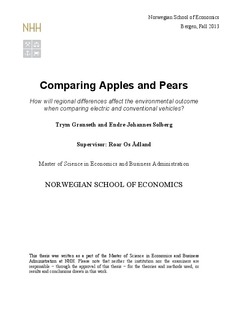Comparing apples and pears : how will regional differences affect the environmental outcome when comparing electric and conventional vehicles?
Master thesis
Permanent lenke
http://hdl.handle.net/11250/194266Utgivelsesdato
2013Metadata
Vis full innførselSamlinger
- Master Thesis [4372]
Sammendrag
In recent years a number of studies have assessed the life cycle emissions of electric
vehicles, with differing focus areas. In this study we sought to further broaden the
comparison of electric vehicles and conventional vehicles by taking into account the
generation of electricity in various countries. This research combine recent existing life cycle
assessments and statistics into a complete analysis of the life cycle CO2 emissions of an
electric vehicle, including emissions at point of use in China, Germany, India, Japan,
Norway and the United States. These results were compared to a conventional vehicle of
similar characteristics, using gasoline or diesel as fuel.
By assuming a vehicle lifetime of 150,000 km, we found that electric vehicles powered with
electricity from either China or India contributes to minor or no environmental savings
relative to conventional vehicles. As 96 % of electricity generation in Norway is derived
from renewable energy sources, driving an electric vehicle offer by far the highest
environmental savings, up to 64 %. When utilizing the electric vehicle in the remaining
countries one achieves CO2 savings of 14 to 27 %, depending on battery applied and fuel of
comparison.
The countries selected in our study accounts for approximately 75 % of the worldwide
electric vehicle fleet. Our results express that 68 % of the fleet suits as an environmentally
friendlier alternative relative to conventional vehicles, while the remaining 25 % remains to
be considered.
